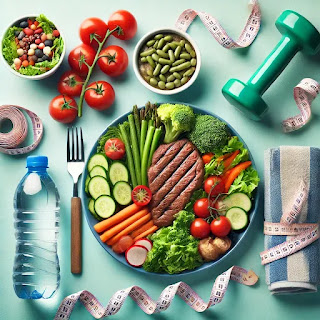The Ultimate Guide to a Healthy Diet for Sustainable Fat Loss
What is the ultimate guide to creating a sustainable meal plan for weight loss?
In a world overflowing with fad diets, miracle pills, and conflicting nutrition advice, losing body fat can feel like navigating a minefield. While quick fixes promise rapid results, sustainable fat loss isn’t about deprivation or extreme measures—it’s about building lifelong habits that prioritize health, balance, and science-backed strategies. This guide breaks down the fundamentals of a healthy diet for fat loss, empowering you to shed excess weight safely while nourishing your body and mind.
Why Most Diets Fail (And What Actually Works)
Before diving into the “how,” it’s crucial to understand the “why.” Many diets fail because they:
- Focus on short-term restrictions(e.g., cutting out entire food groups).
- Ignore individual needs (metabolism, lifestyle, preferences).
- Prioritize rapid weight loss over sustainable habits.
True fat loss requires a calorie deficit—burning more calories than you consume—but how you achieve that deficit matters. Crash diets may lead to quick results, but they often sacrifice muscle mass, slow metabolism, and trigger rebound weight gain. Instead, a balanced, nutrient-dense diet paired with gradual lifestyle changes ensures lasting success.
The Core Principles of a Fat-Loss Diet
1. Prioritize Protein
Protein is the cornerstone of fat loss. It boosts metabolism (via the thermic effect of food), reduces hunger, and preserves lean muscle mass, which is critical for maintaining a healthy metabolic rate. Aim for 0.7–1 gram of protein per pound of body weight daily.
Sources: Chicken, turkey, fish, eggs, Greek yogurt, legumes, tofu, and tempeh.
Tip: Include protein in every meal to stay full longer and curb cravings.
2. Choose Smart Carbohydrates
Carbs aren’t the enemy—refined carbs are. Focus on fiber-rich, complex carbohydrates that stabilize blood sugar and keep energy levels steady.
- Best choices: Whole grains (oats, quinoa, brown rice), vegetables, fruits, and legumes.
- Limit: White bread, pastries, sugary cereals, and sodas.
3. Don’t Fear Healthy Fats
Dietary fats support hormone production, brain health, and satiety. Avoid trans fats and prioritize unsaturated fats.
- Sources: Avocados, nuts, seeds, olive oil, and fatty fish like salmon.
- Portion control: Fats are calorie-dense, so stick to 1–2 tablespoons of oil or a small handful of nuts per serving.
4. Fill Up on Fiber
Fiber slows digestion, keeps you full, and supports gut health. Aim for 25–30 grams daily from whole foods.
- High-fiber foods: Broccoli, berries, chia seeds, lentils, and whole grains.
5. Stay Hydrated
Dehydration is often mistaken for hunger. Drinking water boosts metabolism and helps control appetite.
- Goal: 8–10 cups daily (more if you’re active).
- Pro tip: Start meals with a glass of water to prevent overeating.
Foods to Avoid (or Limit)
While no food is “off-limits,” certain choices hinder fat loss:
1. Ultra-processed foods: Chips, cookies, and frozen meals are loaded with empty calories, additives, and excess sugar.
2. Sugary beverages: Sodas, sweetened coffees, and juices spike insulin and provide no nutritional value.
3. Excessive alcohol: Alcohol slows fat burning and lowers inhibitions, leading to poor food choices.
Sample Meal Plan for Fat Loss
Breakfast:
- Veggie omelet (3 eggs, spinach, mushrooms) + 1 slice of whole-grain toast.
- Or Greek yogurt with berries and a sprinkle of chia seeds.
Mid-Morning Snack:
- Apple slices with 1 tbsp almond butter.
Lunch:
- Grilled chicken salad (mixed greens, cherry tomatoes, cucumber, avocado, olive oil, and lemon dressing).
- Or Lentil soup with a side of roasted veggies.
Afternoon Snack:
- Carrot sticks with hummus.
Dinner:
- Baked salmon with quinoa and steamed broccoli.
- Or Stir-fried tofu with brown rice and asparagus.
Dessert (optional):
- Dark chocolate (70%+ cocoa) or a small bowl of mixed berries.
Practical Tips for Success
1. Practice Portion Control
Even healthy foods can lead to weight gain if portions are oversized. Use these visual cues:
- Protein: Palm-sized portion.
- Carbs: Cupped handful (cooked grains, potatoes).
- Fats: Thumb-sized portion (oils, nut butter).
2. Cook at Home
Restaurant meals are often loaded with hidden calories, salt, and sugar. Preparing meals gives you control over ingredients.
3. Track Progress Mindfully
Weigh yourself weekly (not daily) and take body measurements. Non-scale victories—like improved energy or better sleep—matter too!
4. Eat Mindfully
Slow down, savor each bite, and avoid distractions (like screens). This helps prevent overeating and improves digestion.
5. Allow Flexibility
Deprivation leads to bingeing. Enjoy occasional treats in moderation—a piece of cake at a birthday party won’t derail progress.
The Role of Exercise
While diet drives fat loss, exercise accelerates results by:- Burning extra calories.
- Preserving muscle mass (especially strength training).
- Boosting mood and reducing stress (a common trigger for overeating).
Aim for 150 minutes of moderate cardio (e.g., brisk walking) and 2–3 strength sessions weekly.
Common Pitfalls to Avoid
1. Overestimating Calorie Burn: Exercise doesn’t justify overeating.
2. Skipping Meals: This slows metabolism and increases cravings.
3. Relying on Supplements: Fat-loss pills or detox teas are unregulated and ineffective without diet changes.
The Mental Side of Fat Loss
Sustainable fat loss requires patience and self-compassion. Avoid:
- All-or-nothing thinking: One “bad” meal isn’t failure.
- Comparing yourself to others: Genetics, age, and lifestyle differ—focus on your progress.
Final Thoughts: It’s a Lifestyle, Not a Diet
Fat loss isn’t a destination—it’s a journey rooted in consistency, education, and self-care. By prioritizing whole foods, staying active, and nurturing a positive mindset, you’ll not only lose weight but also gain energy, confidence, and long-term health. Remember, the best diet is one you can maintain happily for life.
Start small. Stay consistent. Celebrate progress.


